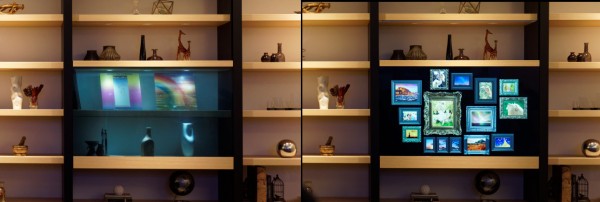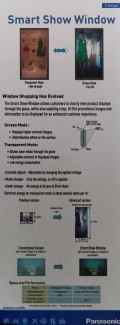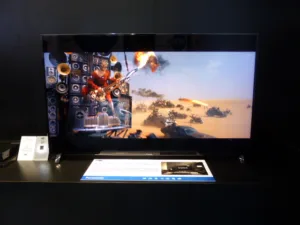Nearby was a demonstration of a projection mapping prototype system, using dynamic motion tracking. There were several demonstrations of this, with the main one using a projector (1024 x 768) around 4.8m from a wall. This projected a circle of light, which would ‘stick’ to a user’s hand. No matter how fast the hand was moved, the light would remain centered on it. The delay was about 1ms. We did take a video of this, but Panasonic’s own is more impressive (or, at least, has better audio). http://tinyurl.com/hvvjeyk
At the far end of the stand, Panasonic was showing its 8k developments. One of these was a transmission system for uncompressed 8k video. A single cable and connector solution was used, rather than today’s method of using multiple cables (commonly four HDMI).
The new cable, which was 30m long, uses plastic optical fibre. High-speed transmission over this material is possible when the optical axes are completely aligned. However, when the equipment and the cable’s connection portions are detachable, this alignment at the connection is difficult. Panasonic, working with KAI Photonics, developed connector-equipped cables using a ‘ballpoint-pen type interconnect’.
Using Panasonic’s technology for the multi-level modulation of broadband signals, a transmission bandwidth exceeding of 144Gbps was achieved. The cable was sending uncompressed 8k video, at 120Hz with 12-bit colour, to a 55″ display. This was showing the content in 10-bit colour (98% Rec.2020), but was otherwise unchanged.
Finally, Panasonic demonstrated a transparent LCD TV, which appeared to have a very good contrast ratio and black levels. Transparent screens often suffer in this regard. Watch a video at http://tinyurl.com/zd4su7y, or find it below.
We talked to Panasonic about the set which is reported to have around 11% transparency, although the firm told us that it wants to get to “as close to 100% as possible” (which suggests a change to OLED technology). The demonstrator clearly had a “single pixel” black layer, presumably from a liquid crystal layer, as without it, transparent displays cannot make black. Mass production is likely to be two to five years away.
 Panasonic’s transparent TV demo – Transparent on the left, TV on the right. Click for higher quality. Image:Meko Ltd
Panasonic’s transparent TV demo – Transparent on the left, TV on the right. Click for higher quality. Image:Meko Ltd
 Panasonic’s transparent RP screen explained. Click for higher resolution. Image:Meko LtdThere was also a very interesting demonstration of a Liquid-crystal-based rear projection screen. Few technical details were available (see graphic on the right) as it was a “technology demonstration”, but the screen was able to switch between a transparent mode and a rear projection mode, when it looked opaque. One member of staff told us that transparency was switching between 20% and 70%. Another engineer from Japan told us that the screen was based on a glass/film/glass laminate. We suggested that the layer of film might be “something like” a cholesteric LCD and the engineer agreed that it was “something like it”.
Panasonic’s transparent RP screen explained. Click for higher resolution. Image:Meko LtdThere was also a very interesting demonstration of a Liquid-crystal-based rear projection screen. Few technical details were available (see graphic on the right) as it was a “technology demonstration”, but the screen was able to switch between a transparent mode and a rear projection mode, when it looked opaque. One member of staff told us that transparency was switching between 20% and 70%. Another engineer from Japan told us that the screen was based on a glass/film/glass laminate. We suggested that the layer of film might be “something like” a cholesteric LCD and the engineer agreed that it was “something like it”.
The rear projector being used was a 12,000 lumens unit and gave a good quality image.
We also heard that Panasonic will show UltraHD+ projectors later in the year, using a “quad pixel drive” system that will use a 2560 x 1440 imager with motion to create additional pixels. Panasonic told us that the TI 4K DLP chips are very large and that poses problems in getting systems down to the dimensions that the market wants. (See our story on TI for an update on this Texas Instruments is Looking forward to Overall Unit Growth in DLP Chips)
Analyst Comment
The transparent TV demonstration was getting a lot of genuine desire and interest as Panasonic had cleverly designed the TV to match the furniture it was mounted on. As a result, it became almost invisible to a casual glance. Many visitors were excited by the idea and maybe Panasonic will take up the idea that Loewe had a number of years ago, of working with a high end furniture company to develop the concept. On the other hand, Panasonic has so many products and divisions that it wouldn’t entirely surprise us if it got into the furniture business! (BR)

